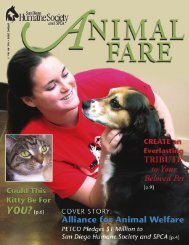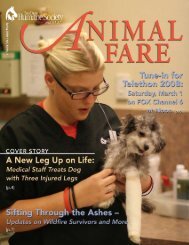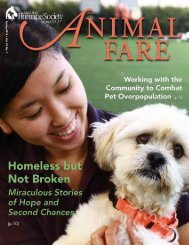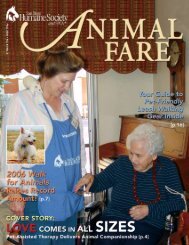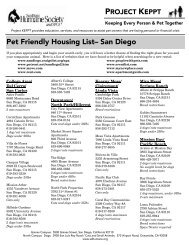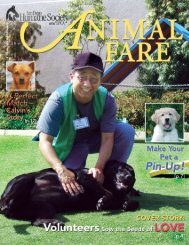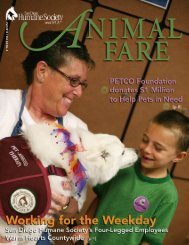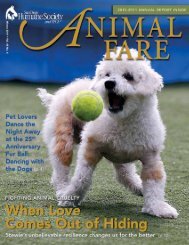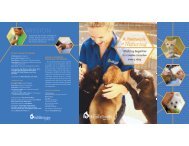Fall 2007 ⢠V ol. 42 No. 3 - San Diego Humane Society and SPCA
Fall 2007 ⢠V ol. 42 No. 3 - San Diego Humane Society and SPCA
Fall 2007 ⢠V ol. 42 No. 3 - San Diego Humane Society and SPCA
Create successful ePaper yourself
Turn your PDF publications into a flip-book with our unique Google optimized e-Paper software.
Ask Doctor B<br />
THE LOW-DOWN ON HIP DYSPLASIA<br />
Q: I am planning on adopting<br />
a larger-sized dog <strong>and</strong> have heard<br />
that bigger dogs can be effected<br />
by a condition called Hip<br />
Dysplasia. What is Hip Dysplasia<br />
<strong>and</strong> what kind of effect does it<br />
have on dogs? Also, what are the<br />
treatments available for dogs with<br />
Hip Dysplasia?<br />
– Eager to adopt in Alpine, CA<br />
A: Thank you for your question.<br />
Although Hip Dysplasia (HD) is a<br />
common condition <strong>and</strong> can occur in any<br />
size dog <strong>and</strong> sometimes even cats, you<br />
are correct in that the condition is most<br />
prevalent <strong>and</strong> problematic for larger<br />
dogs (dogs weighing 40-pounds or more).<br />
A dog’s hip joint is made up of a<br />
ball (femoral head) <strong>and</strong> a socket (pelvic<br />
acetabulum). <strong>No</strong>rmally, the bone<br />
structure of the socket <strong>and</strong> the soft<br />
tissues of the joint (ligaments, tendons,<br />
<strong>and</strong> joint capsule) tightly h<strong>ol</strong>d the ball<br />
inside the socket, allowing for normal<br />
rotary action of the hip when a dog<br />
walks, runs or jumps.<br />
In a dog with HD, the joint is<br />
dysplastic or “too loose.” In a<br />
dysplastic joint, the ball does not<br />
fit tightly in the socket, allowing for<br />
too much movement in the joint, which<br />
in turn, creates abnormal “rubbing”<br />
between the bones that make up the<br />
ball <strong>and</strong> socket. Over time this rubbing<br />
causes degenerative changes in the<br />
joint <strong>and</strong> leads to the development of<br />
Osteoarthritis. It is the arthritis that<br />
creates the symptoms that we see in<br />
dogs with HD, including difficulty<br />
rising after sleeping, lameness, pain<br />
when the hind legs are manipulated<br />
<strong>and</strong> a reluctance to play or move<br />
quickly. Unfortunately these symptoms<br />
are often progressive, meaning that<br />
they worsen with age <strong>and</strong> time.<br />
While HD is known to be a genetic<br />
condition, the exact mechanism of<br />
the genetics is still not understood.<br />
However, the condition is definitely<br />
more common in certain breeds of<br />
dogs. German Shepherds, Labrador<br />
Retrievers, G<strong>ol</strong>den Retrievers, <strong>and</strong><br />
Rottweilers are all breeds commonly<br />
affected by HD. Of the large breed dogs,<br />
St<strong>and</strong>ard Poodles <strong>and</strong> Greyhounds are<br />
two breeds that appear to be affected<br />
least often by the condition.<br />
The good news is that if a dog<br />
develops arthritis as a result of HD,<br />
there are a number of treatments that<br />
can help manage the dog’s pain <strong>and</strong>/or<br />
stiffness. For example, <strong>No</strong>n-Steroidal<br />
Anti-Inflammatory drugs (NSAIDs),<br />
such as Rimadyl or EtoGesic, are<br />
commonly used <strong>and</strong> make a marked<br />
difference in the quality of life for a dog<br />
with HD. The downside to prescribing<br />
NSAIDs is that they can cause side<br />
effects; however, the incidence is very<br />
low <strong>and</strong> for the vast majority of pets<br />
that take the medications their quality<br />
of life is greatly improved.<br />
Nutritional supplements like<br />
glucosamine, chondrotin, <strong>and</strong> omega-3<br />
fatty acids may have some long-term<br />
beneficial effects for dogs with HD. In<br />
addition, homeopathic treatments such<br />
as physical therapy, swimming <strong>and</strong><br />
canine massage can also be helpful in<br />
easing a dog’s stiffness <strong>and</strong> pain. Lastly,<br />
contr<strong>ol</strong>ling a dog’s weight <strong>and</strong> keeping<br />
him on a consistent exercise program<br />
can also be beneficial in reducing some<br />
of the effects of HD.<br />
In addition to medications,<br />
nutritional supplements <strong>and</strong> weight<br />
loss, there are a number of surgical<br />
treatments available for dogs with HD.<br />
Some of these surgical procedures are<br />
used with young dogs whose HD has<br />
been diagnosed by Xrays, but has not<br />
yet caused arthritis or secondary<br />
degenerative joint disease. Other<br />
surgical procedures are utilized to<br />
alleviate pain <strong>and</strong> discomfort after a<br />
dog has developed arthritis.<br />
Although Hip Dysplasia can be a<br />
very significant health issue for a dog,<br />
during the last decade, medications <strong>and</strong><br />
even surgeries have been developed to<br />
allow dogs with HD to live pain free for<br />
many years.<br />
Sincerely,<br />
Jim Babbitt, D.V.M.<br />
<strong>San</strong> <strong>Diego</strong> <strong>Humane</strong> <strong>Society</strong> <strong>and</strong> <strong>SPCA</strong><br />
For more interesting <strong>and</strong> informative<br />
articles on caring for your pet, please<br />
visit www.sdhumane.org. Or, if you<br />
have a veterinary question or issue<br />
you would like to see addressed in this<br />
c<strong>ol</strong>umn, email info@sdhumane.org with<br />
“ASK DR. B” in the subject line.<br />
16 www.sdhumane.org<br />
AnimalFare • <strong>Fall</strong> <strong>2007</strong>



